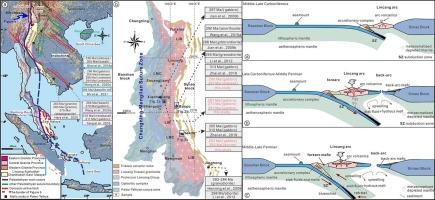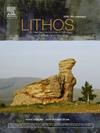云南西部古太古宙的时空演化:澜沧构造带岩浆岩的启示
IF 2.9
2区 地球科学
Q2 GEOCHEMISTRY & GEOPHYSICS
引用次数: 0
摘要
青藏高原东南部的三江造山带为古泰西构造演化提供了极好的记录。本研究通过对澜沧江造山带晚古生代岩浆岩的锆石UPb年龄、原位LuHf同位素数据以及全岩主要氧化物、微量元素和Sr-Nd-Pb同位素组成的分析,对古生代特提斯构造演化的时空关系提出了新的约束。小黑江、半坡和崖口地区岩浆岩的年代分别约为281-267Ma、295-292Ma和293-291Ma。小黑江岩浆岩的地球化学特征与前弧玄武岩相似,表现为低(La/Sm)N、相对平坦的稀土元素(REE)归一化模式、正εNd(t)值(+5.6至+10.1)和锆石原位εHf(t)值(+10.0至+14.9)。这些特征表明,它们的成因来自贫化地幔源,并有少量板块成因成分。Banpo和Yakou岩浆岩显示出与后弧盆玄武岩的地球化学亲缘关系,类似于冲绳海槽后弧盆玄武岩。它们的εNd(t)值在+5.6到+9.9之间,εHf(t)值在+9.5到+15.0之间,这表明它们来自经板块衍生流体或熔体修饰的地幔楔源。结合澜沧构造带沿线古特提斯演化的现有地质年代数据,我们的发现支持了古特提斯洋低速、低角度俯冲导致弧前增生复合体形成的假说。随着俯冲深度和角度的增加,板块衍生流体使地幔楔变质,促进了临沧弧岩浆活动的发展和半坡-雅口后弧盆地的形成。持续的俯冲促进了板块在重力作用下的后退,诱发了贫化地幔的上涌和前弧岩浆的形成。本文章由计算机程序翻译,如有差异,请以英文原文为准。

Spatio-temporal evolution of the Paleo-Tethys in western Yunnan: Insights from mafic rocks in the Lancang tectonic belt
The Sanjiang orogenic belt in the southeastern Tibetan Plateau provides an excellent record of the Paleo-Tethys tectonic evolution. This study introduces new constraints on the spatio-temporal evolution of the Paleo-Tethys through zircon U![]() Pb ages, in-situ Lu
Pb ages, in-situ Lu![]() Hf isotope data, and analyses of whole-rock major oxides, trace elements, and Sr-Nd-Pb isotopic compositions from Late Paleozoic mafic rocks in the Lancang tectonic belt. The mafic rocks from the Xiaoheijiang, Banpo, and Yakou areas were dated to approximately 281–267 Ma, 295–292 Ma, and 293–291 Ma, respectively. The Xiaoheijiang mafic rocks exhibit geochemical signatures resembling those of fore-arc basalt, characterized by low (La/Sm)N, relatively flat rare earth element (REE)-normalized patterns, positive εNd(t) (+5.6 to +10.1), and zircon in-situ εHf(t) values (+10.0 to +14.9). These features indicate an origin from a depleted mantle source with minor contributions from slab-derived components. The Banpo and Yakou mafic rocks display geochemical affinities to back-arc basin basalt, similar to the Okinawa Trough back-arc basin basalt. Their εNd(t) values range from +5.6 to +9.9 and εHf(t) values from +9.5 to +15.0, suggesting derivation from a mantle wedge source modified by slab-derived fluids or melts. In combination with available geochronological data concerning the Paleo-Tethys evolution along the Lancang tectonic belt, our findings support the hypothesis that the slow-speed, low-angle subduction of the Paleo-Tethys Ocean led to the formation of a forearc accretionary complex. The slab-derived fluids metasomatized the mantle wedge as subduction depth and angle increased, facilitating the development of the Lincang arc magmatism and the opening of the Banpo-Yakou back-arc basin. Continuous subduction promoted slab retreat under gravitational forces, inducing the upwelling of depleted mantle and the forming of forearc magmas.
Hf isotope data, and analyses of whole-rock major oxides, trace elements, and Sr-Nd-Pb isotopic compositions from Late Paleozoic mafic rocks in the Lancang tectonic belt. The mafic rocks from the Xiaoheijiang, Banpo, and Yakou areas were dated to approximately 281–267 Ma, 295–292 Ma, and 293–291 Ma, respectively. The Xiaoheijiang mafic rocks exhibit geochemical signatures resembling those of fore-arc basalt, characterized by low (La/Sm)N, relatively flat rare earth element (REE)-normalized patterns, positive εNd(t) (+5.6 to +10.1), and zircon in-situ εHf(t) values (+10.0 to +14.9). These features indicate an origin from a depleted mantle source with minor contributions from slab-derived components. The Banpo and Yakou mafic rocks display geochemical affinities to back-arc basin basalt, similar to the Okinawa Trough back-arc basin basalt. Their εNd(t) values range from +5.6 to +9.9 and εHf(t) values from +9.5 to +15.0, suggesting derivation from a mantle wedge source modified by slab-derived fluids or melts. In combination with available geochronological data concerning the Paleo-Tethys evolution along the Lancang tectonic belt, our findings support the hypothesis that the slow-speed, low-angle subduction of the Paleo-Tethys Ocean led to the formation of a forearc accretionary complex. The slab-derived fluids metasomatized the mantle wedge as subduction depth and angle increased, facilitating the development of the Lincang arc magmatism and the opening of the Banpo-Yakou back-arc basin. Continuous subduction promoted slab retreat under gravitational forces, inducing the upwelling of depleted mantle and the forming of forearc magmas.
求助全文
通过发布文献求助,成功后即可免费获取论文全文。
去求助
来源期刊

Lithos
地学-地球化学与地球物理
CiteScore
6.80
自引率
11.40%
发文量
286
审稿时长
3.5 months
期刊介绍:
Lithos publishes original research papers on the petrology, geochemistry and petrogenesis of igneous and metamorphic rocks. Papers on mineralogy/mineral physics related to petrology and petrogenetic problems are also welcomed.
 求助内容:
求助内容: 应助结果提醒方式:
应助结果提醒方式:


